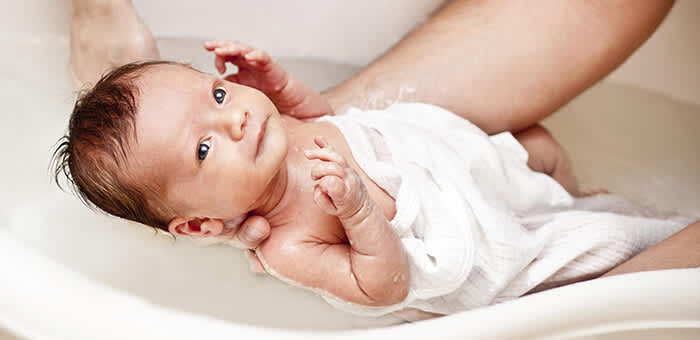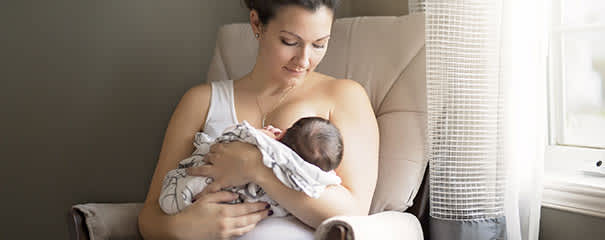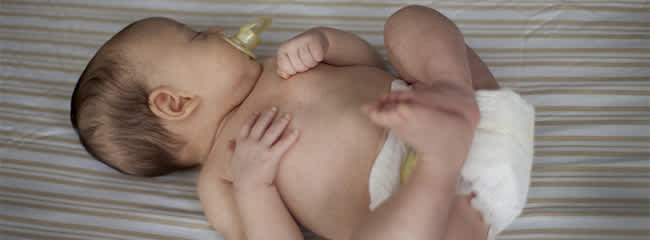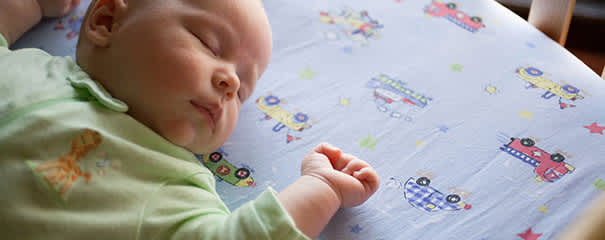New Born
Baby’s First Bath
Your baby's first bath is a real milestone. But when to give it, not to mention how and where, are questions every new parent has. Cleaning a slippery, squirming – and sometimes screaming – infant takes practice. So relax; it will get easier every time, and your baby will soon come to love splashing in the water. Find baby bath procedure and tips below.
How Often Do You Need to Bathe Your Baby?
For a newborn, two or three times a week is probably enough, as long as you keep her nappy area well-cleaned and wash her hands and face several times a day (top and tail). Unless they've been sick or soiled themselves, newborns just don't get that dirty.
For older babies, it can be as much as every day as bath time often becomes part of the bedtime routine. It can be a great way to help your baby relax and wind down for the night.
Sponge Bathing Your Newborn Baby
Before your baby's umbilical cord stump falls off (between 10 days and three weeks after birth), it's best to sponge-bathe her to avoid getting the cord stump wet.
Here's how:
Lay your baby on a soft, flat surface (on top of a clean towel works well). Have a basin of warm water and a sponge or flannel handy. Know tips on how to bathe a baby
Keeping your baby warmly wrapped, expose one limb at a time and gently wash it.
Pat the area dry and start on the next limb.
If you accidentally get the cord stump wet, simply use the towel to gently pat it dry. Find out tips on how to take care of umbilical stump
Baby Bathing Tips
Once the cord stump has fallen off, your baby is ready for a real bath procedure in the sink or a baby bath tub. Whichever you use, pad the bottom with a towel to make it softer. You also might want to have a partner nearby to help you hold on to your slippery little one. Assemble everything you'll need beforehand so you won't have to scramble during the bath.
Here's a sample list:
- A large, hooded towel
- A soft flannel or sponge
- Cotton balls
- Baby soap or bath wash
- A baby brush or comb
You'll only need about 5 cm (2 inches) of warm water to give your baby an effective bath. Try placing a warm flannel over her belly to keep her from getting chilled.
These early baths don't need to be long or involved, but they do need to get the job done. Hold your baby firmly and gently wash away any dirt or loose skin that's accumulated. You'll have to cradle her head and back as you wash her. As you wash her, pay particular attention to:
- The genital and nappy areas
- The hands and feet. Check between the fingers and toes as well.
- The folds at the backs of the knees, the neck and the thighs.
- The face. If dirt has accumulated around her eyes, use a cotton ball to swab it away.
- Armpits – fuzz from sleep-suits can accumulate here.
- Behind the ears
Newborn Hair & Cradle Care
Not every baby is blessed with a full head of hair at birth, but if your baby was, wash it with a gentle baby shampoo as needed. Simply apply a dab of shampoo to her hair, gently massage it in and let it sit for a short while before rinsing it out. Wash your baby's hair last so she doesn't have to sit in soapy water.
Temperature Of Bathing Water For Babies
Your baby's skin is more sensitive than yours. As a result, bath water that feels comfortable to you will be too hot for her. Before you put your baby anywhere near the water, test it with the back of your wrist or your elbow: These areas are more sensitive to heat than your hand. The water should feel warm – but not hot!
Finally, don't be surprised if your baby cries during her first few baths. She's just reacting to an unfamiliar sensation. Keep the room temperature warm, the bath water comfortable and soothe her by caressing and singing to her. She'll soon learn to love bath time.
Get expert tips on how to take care of a newborn baby?
From week by week expert tips on pregnancy calendar to new born baby care tips, Pampers India is here to guide you through the amazing journey of early parenthood. Learn more about Pampers baby diapers
Breast Milk Production: Here’s Everything You Need To Know!
When you begin breastfeeding, you may wonder if your baby is getting properly nourished. If you notice your baby is not gaining weight or getting through diapers, it could be that your baby is not getting enough breast milk. This can happen if your baby is not latching on correctly or, in rarer cases, if your milk supply is running low. The good news is that most women produce one-third more breast milk than their babies will drink, so there’s a little leeway. It's always wise to talk to your doctor if you have any breastfeeding problems. If you are worried about your milk production levels, read on to discover ways to increase your milk supply naturally, and learn why you may be lactating less than you would like.
Signs Your Baby Is Getting Enough Breast Milk
Instead of trying to gauge the quantity of your breast milk production, it’s more important to keep an eye on signs that your baby is getting enough milk. Think about these questions:
Is your baby gaining weight? One of the most reliable signs of successful feeding is your baby’s steady weight gain. Keep in mind your baby will likely lose a little weight within a few days of birth (usually no more than about 7 percent of baby’s birth weight), but this should be regained within a couple of weeks. Take a look at this growth chart, which will help you track your baby’s development along with your baby’s doctor
Is your baby getting through diapers? Is your baby gaining weight? The number of newborn diapers your baby goes through is a good indicator of enough breast milk supply. Expect to change six wet diapers per day, and check that your baby has three to four bowel movements a day. The stool will be dark and sticky in those first days after your baby is born, but will become loose and yellowish afterwards. The colour of the urine should be pale yellow – not dark yellow or orange in colour.
How often does your baby breastfeed? Newborns tend to feed 8 to 12 times a day, approximately every two to three hours. This demand may increase with growth spurts.
Does your baby seem happy between feeds? If your baby seems satisfied, happy, alert, and active (not cranky or fussy) after feedings, chances are she is getting the nourishment she needs.
If your baby isn’t getting enough milk, you may also notice that she is sleepy all the time or most of the time. Be sure to call your baby's doctor if this is the case. Learn about new born baby care.
What Affects Breast Milk Production?
If your newborn isn’t getting the nutrition she needs, it’s more likely to be because she is not latching onto your breast correctly as opposed to you not producing enough milk. Read up on how to get your baby to latch on correctly for some extra tips. Nevertheless, there are some factors that can cause your breast milk production to decrease, including:
- Waiting too long to start breastfeeding (ideally you may aim to start breastfeeding about an hour or so after giving birth, however, in some cases this may not be possible)
- Not breastfeeding often enough (experts recommend breastfeeding about 8 to 12 times a day)
- Using certain medications, such as those containing pseudoephedrine or even certain types of hormonal contraception
- Your baby not latching on correctly and therefore not prompting the production of milk
- Having had breast surgery
- If your baby was born prematurely
- If you have pregnancy-induced high blood pressure
- Obesity
- If you have insulin-dependent diabetes.
How to Produce More Breast Milk
The good news is there are ways to increase your milk supply. These ideas may help avoid breast feeding problems:
Breastfeeding as soon as you can. If you can, try not to wait too long after the birth of your baby to begin breastfeeding. Ideally you can start within one hour or so. However, in some cases, for example, if you’re recovering from a caesarean section, you may end up starting to breastfeed later. Don’t worry if this is the case for you, because below we have even more tips on increasing your breast milk supply.
Use a breast pump regularly. The more you can pump, the more breast milk you’ll produce. If you’re working, try to pump for 15 minutes every few hours. You can also save some time by pumping both breasts at the same time with a double breast pump.
Breastfeed often. Your baby will probably want to feed 8 to 12 times a day. If your baby feeds often or you use a breast pump between feeds, your breasts will be stimulated into making more milk.
Make sure baby’s latching on properly. It’s important your baby latches on correctly and swallows while feeding. If in doubt, a lactation consultant or your doctor will be able to help you confirm whether your baby has latched on and is swallowing properly.
Feed from both breasts. Remember to alternate between breasts. Both need to be drained to produce more milk. You can also use a pump to express any built-up milk. Milk build-up can lead to conditions like the breast infection called mastitis. To help fully drain both breasts you could also consider alternating breastfeeding positions.
Don’t skip feeding times. You’ll want to keep your feeding schedule up. If you’re working while breastfeeding and you’re pumping breast milk, try not to miss any sessions, as this can affect your milk supply.
Talk to your doctor about medications. Some medications can decrease milk production. Discuss your medication options with your doctor, as solutions may be available that are suitable to take while breastfeeding.
Seek help from a lactation consultant. If you’re still unsure whether you’re producing enough milk for your baby, talk to a lactation consultant or your doctor for personalised guidance.
Above all, don’t worry! Even if you feel your milk supply is on the low side, there are steps you can take to increase breast milk production. By following these breastfeeding tips and talking to your doctor, you can make sure your baby is getting the nourishment your baby needs.
How much should a newborn sleep?
It's been a long day at the hospital. Your new baby is probably snuggling up to you for her first small sleeps and she'll be at it for a while.
“I never realised how much skin-to skin contact with my baby mattered. When it s time for bed and she feels distressed, we spend some time touching and reassuring, then she quickly calms down.”
Germaine, mum of Amos, 3 months
During the first few weeks, newborns can sleep up to 16-20 hours a day in 3-4 hour stretches.
Make sure that they sleep safely and peacefully by:
- Placing baby to sleep on her back on a firm surface.
- Keeping extras like pillows, stuffed animals and duvets out of the cot.
- Sleeping near baby but not in the same bed.
- Maintaining room temperature at the low to mid-twenties Celsius (around 22 ºC) or around 70 °F.
Mum Tips
- Help your baby to learn the difference between night and day by keeping light dimmed during the night and bright during the day.
- Always feed and change baby's nappy just before bed.
- Newborns spend so much time on their backs sleeping that it is important to give them plenty of time on their tummies, or in an upright position when they are awake.
- Avoid unnecessary wake-ups by choosing a nappy that's comfortable and gives lasting dryness, like Pampers Swaddlers.
- Your newborn will need to eat approximately every three hours, around the clock. But don't worry, over time she will learn to go longer between feeds and sleep longer overnight (with a few naps during the day).
Here is a rough guide to sleep by age:
- Newborn: 16-20 hours per day
- 6 Weeks: 15-16 hours per day
- 4 Months: 9-12 hours plus 2 naps
- 6 Months: 11 hours plus 2 naps
- 9 Months: 11-12 hours plus 2 naps
- 1 Year: 10-11 hours plus 2 naps
What Is SIDS, and How Can I Reduce the Risk?
You might have heard of SIDS, a topic of concern for mums of young children. SIDS stands for Sudden Infant Death Syndrome, and it refers to the unexpected and unexplained death of an otherwise healthy baby who is less than a year old. It’s sometimes called cot death, because many SIDS babies die when they're sleeping. The chance of SIDS occurring is very low, affecting about 0.0001 percent of infants under a year old in India. The cause or causes of SIDS are not known; however, there are steps you can take to create a safe sleep environment for your baby and to help prevent SIDS. Read on to find out more about what SIDS is, what some of the risk factors may be, and what you can do to help prevent it.
What Is Sudden Infant Death Syndrome?
What Is Sudden Infant Death Syndrome?
The definition of SIDS is more a matter of what it isn’t: it is a death that is unexplained and unexpected, and that usually occurs while the baby is sleeping.
If you're wondering just how common SIDS is, statistics show SIDS is very rare in India. Based on data from 2013, the rate of SIDS is 0.1 deaths per 100,000 live births. This may still sound alarming, but it means only 0.0001 percent of babies under 1 year old are victims of SIDS.
A natural question parents have is when can I stop worrying about SIDS? Most SIDS deaths occur in the first several months of a baby’s life, and in fact, infants are most vulnerable between the second and fourth months. The SIDS risk significantly decreases after your baby turns 1.
Safe Sleep and SIDS Prevention Tips
It's important to know how to help prevent SIDS. Take these steps to help keep your baby safe and lower the risk of SIDS:
Put your baby to sleep on his back. Do this every single time for the first year of his life, and tell anyone else who may care for him that this is a must, whether it’s for a nap or to sleep at night. A good way to remember is with the expression ‘Back to sleep’. Some babies turn onto their stomach or side after being placed on their backs; it's OK to leave them in that position, experts say, as long as they are able to roll over in both directions without help.
Keep the cot bare. Make sure the mattress in the cot is firm and fits the cot perfectly without leaving any gaps at the sides. Avoid using any padding, blankets, comforters, pillows, bumper pads, or quilts. Only a tight-fitting fitted sheet should be used — no loose bedding. Never place toys in the cot — not even soft teddy bears. These fluffy surfaces and objects can interfere with your baby’s breathing.
Move your baby to a firm surface. Sometimes your baby may fall asleep in the car seat, stroller, or sling. Move him to a firm sleep surface as soon as possible. Never put your baby to sleep on a water bed or a cushion.
Don't let your baby become overheated. Avoid letting your baby get too hot, as this increases the SIDS risk. Make sure his head isn't covered when you put him to bed. Ensure the air temperature is comfortable for you — make sure it’s not too hot. Dress your baby in no more than one extra layer than you would wear, and don't use blankets. Instead, try a wearable blanket or a sleeping sack with no hood, or footie pyjamas. If your baby’s head is hot and sweaty, or if his chest feels hot, he's too warm.
Let your baby sleep in your room. While this depends on your personal preferences, experts recommend your baby sleep in your room with you, but alone in a cot. If possible, try this for up to a year, and consider keeping the cot or bassinet at about an arm's length away from your bed.
Don’t sleep with your baby. Sleeping in the same bed as your baby isn’t recommended, and here’s why. It increases the SIDS risk because you can accidentally roll onto your child as you sleep, and the baby is at risk of becoming entangled in the bedding.
Breastfeed your baby. If you can, breastfeed for at least the first six months. Research suggests this can significantly reduce the risk of SIDS.
Skin to skin contact. Skin to skin contact has many benefits. You can practice it while breastfeeding or bottle-feeding, or any other time throughout the day.
Don't rely on a SIDS baby monitor. Experts discourage the use of monitors and other devices that are claimed to reduce SIDS, because they have been found to be ineffective.
Offer a dummy. Sucking on a dummy at naptime and bedtime might reduce the risk of SIDS. But don’t use dummies with a strap or string, or ones that attach to clothing. If you're breastfeeding, wait until your baby is 3 to 4 weeks old and you've settled into a nursing routine before offering a dummy. If the dummy falls out of your baby's mouth while he is sleeping, don't put it back in.
Make sure your baby gets all necessary immunisations. Some research indicates immunisations can help prevent SIDS.
No smoking around your baby. Don’t smoke near your baby, and keep your car and home smoke-free, too. Keep your baby away from places where people smoke.
Make sure baby beds and gear are safe. The cot, bassinet, stroller, and play yard should all meet current safety standards. Do not use the item if it’s broken, and if you’re borrowing or using a hand-me-down, make sure it meets current regulations.
Don’t fall asleep while feeding your baby. It is better to feed your baby on your bed with all pillows and bedding removed than on a sofa or cushioned chair. If you fall asleep while breastfeeding, move your baby back to his cot as soon as you wake up.
Tummy time. Give your baby plenty of tummy time when he's awake, as it helps strengthen his neck and back muscles. Remember to supervise tummy time, making sure that your baby remains awake.
This is a lot to take in, but this slogan might help. Just remember the ABC's of Safe Sleep: Your baby should always sleep
- ALONE
- on her BACK
- in a COT.
SIDS Risk Factors and Causes
It’s not known exactly what causes SIDS, but there are some environmental factors that make a baby more vulnerable, as well as maternal, physical, and general factors that may increase the risk.
Sleep Environmental Factors
Sleep circumstances that increase SIDS risk include:
Stomach or side sleeping positions. Babies who are placed on their stomach or side may have more difficulty breathing than those placed on their backs.
Sleeping on a soft surface. Sleeping on a cushy comforter, a soft mattress, or a waterbed can block a baby’s airways.
Sharing a bed. Sleeping in the same bed as the parents, siblings, or pets increases the risk of SIDS, because of the potential for blocking the baby’s airways.
Overheating. Being too warm while sleeping can increase the risk of SIDS.
Maternal Risk Factors
Even before birth, mums can also unwittingly increase their baby's SIDS risk. Maternal risk factors include if mum
- is younger than 20
- smokes cigarettes
- consumes drugs or alcohol
- has had inadequate prenatal care. That’s why it’s important to schedule and go to all your prenatal visits.
Physical Factors
Brain defects. In some babies, the portion of the brain that controls breathing and arousal from sleep hasn't matured enough to work properly, making them more vulnerable to SIDS.
Low birth weight. Premature babies, or those who are twins or other multiples, may not have developed full control over their breathing and heart rate yet, potentially making them more vulnerable.
Respiratory infection. Having recently had a cold may contribute to breathing problems for babies, which can increase the risk.
General Risk Factors
Although the exact cause of Sudden Infant Death Syndrome is unknown, these factors contribute to the overall risk:
Sex. Boys are slightly more likely to be affected by SIDS.
Age. Infants are most vulnerable between the second and fourth months of life, although until the age of 12 months, babies are still considered as being at risk.
Family history. There’s a higher risk among babies who've had siblings or cousins die of SIDS.
Tobacco smoke. Babies who live with smokers are at an increased risk.
Premature birth and low birth weight. Being born early and/or having a low birth weight can increase the risk.
SIDS is a risk that almost all mums worry about. Keep in mind that SIDS is rare, and if you take these precautions consistently throughout your baby’s first year of life, you can help reduce the risk even further.
Formula-feeding guidelines
Not everyone chooses to breastfeeding, in which case formula milk in a baby feeding bottle can provide a nutritious alternative. What’s involved? You will need several baby feeding bottles, formulae powder and a sterilizing system. Its really important to make sure all equipment is completely clean to avoid bacteria developing. Wash all the equipment in warm soapy water using a specially designed bottle brush to clean teats and the bottles. Then sterilize the equipment to kill off any left behind bacteria. Remember to thoroughly clean the work surface too.
Making the formula
Prepare the formula for your newborn according to the manufacturer’s instructions, using the scoop provided to ensure measurements are accurate. Use boiled tap water that has been boiled within the last 30 minutes; the water needs to be no less than 70 ºC
Bottle Feeding Your Baby
Before bottle feeding your baby, check the temperature by squeezing a couple of drops on your inner wrist, it should feel warm but not hot. Follow your baby’s lead, remember, each baby is unique and will vary their intake from feeding to feeding, and day to day. Don’t encourage your abby to finish a bottle if they seem to have lost interest. Always through away any milk left over rather than saving for later.
Here's a rough idea of how much milk does a baby need, and how often she needs to be fed with the formula feeding chart given below:
| Age: | Amount per feeding: | Feeding Frequency: |
|---|---|---|
| Newborn | 60 to 90 ml (2 to 3 ounces) | Every 3 to 4 hours |
| One month | 120 ml (4 ounces) | Every 4 hours |
| Two months | 120 ml (4 ounces) | 6 to 7 feedings/24 hours |
| Four months | 120 to 180 ml (4 to 6 ounces) | 6 feedings/24 hours |
| Six months | 180 to 240 ml (6 to 8 ounces) | 5 feedings/24 hours |
| One year | 240 ml (8 ounces) | 2 to 3 feedings/24 hours supplemented with baby food |
Follow your baby’s lead
Remember, each baby is unique and will vary her intake from feeding to feeding, and day to day.
Also, find out tips on breastfeeding here.
From week by week expert tips on pregnancy calendar to new born baby care tips, Pampers India is here to guide you through the amazing journey of early parenthood. Learn more about us, our baby diaper products & commitment to you.





